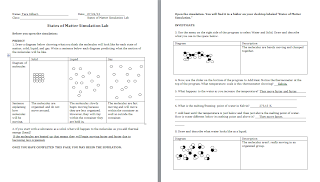Tasks to be completed for Activity 6:
1. Convert 0°F, 32°F, 70°F, and 212°F to Kelvin:
1. Convert 0°F, 32°F, 70°F, and 212°F to Kelvin:
|
Fehrenheit.
|
Kelvin.
|
|
0 degrees.
|
2.55.37 degrees.
|
|
32 degrees.
|
273.15 degrees.
|
|
70 degrees.
|
294.26 degrees.
|
|
212 degrees.
|
373.15 degrees.
|
2. Complete the Teaching Idea: States of Matter Simulation Lab by Kelly Vaughan. Complete the lab worksheet as if you were a student, and then post this on your blog. You can scan it or just take a picture of it.
3. In the States of Matter simulation, choose the Solid, Liquid, and Gas Tab at the top of the screen. Choose the water molecule and cool the water to 0 K. Describe how the water molecules are aligned and attracted to each other. Which atoms are attracted to which other atoms?
The hydrogen molecules seem to be attracted to the oxygen
molecules. The molecules are barely
moving.
4. Switch to the Phase Changes Tab on the States of Matter simulation. Notice how on the bottom right there is a small red dot that indicates where the system is at as far as temperature, pressure and state of matter. Play with the simulation to notice changes, notice that when you push down the pressure can go way up and explode the box. On your blog, report a temperature and pressure required to make oxygen a liquid. This is sometimes how the oxygen exists in pressurized oxygen tanks, perhaps like ones you may use to go diving.
4. Switch to the Phase Changes Tab on the States of Matter simulation. Notice how on the bottom right there is a small red dot that indicates where the system is at as far as temperature, pressure and state of matter. Play with the simulation to notice changes, notice that when you push down the pressure can go way up and explode the box. On your blog, report a temperature and pressure required to make oxygen a liquid. This is sometimes how the oxygen exists in pressurized oxygen tanks, perhaps like ones you may use to go diving.
Oxygen turns to a liquid at about 71K and .35 ATM.
5. List and describe at least two Science Standards that this activity addresses.
5. List and describe at least two Science Standards that this activity addresses.
A.8.6 Use models and explanations to predict actions and
events in the natural world.
C.8.8 Use computer software and other technologies to
organize, process, and present their data.


No comments:
Post a Comment